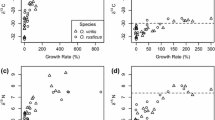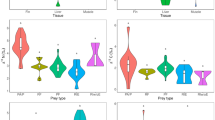Abstract
Our experimental study was designed to assess the effects of temperature on nitrogen isotope turnover and to measure the effects of temperature and food quality on the stable carbon and nitrogen isotope discrimination factors (Δ13C and Δ15N) in a cladoceran. For the first part of our study, Daphnia were fed with non-enriched or 15N-enriched Scenedesmus obliquus at 12, 15, 20, and 25 °C. For the second part, Daphnia were reared at 15, 20, and 25 °C on Scenedesmus or Cryptomonas sp. There were no clear effects of temperature on turnover rates of the nitrogen isotope of cladocerans. However, a general increase in Δ13C with increasing temperature was measured, regardless of the food source. Δ15N was also affected by temperature, but contrasting results were measured depending on the food source used. There were significant effects of food quality on Δ13C and Δ15N in Daphnia, as values obtained for Daphnia fed Scenedesmus were always higher than those obtained for Daphnia fed Cryptomonas. Our experiments produced discrimination factors that were very different from those usually considered in isotope studies and showed that the values used for isotope model implementation to analyze field data need to be adapted to environmental conditions.




Similar content being viewed by others
References
Aberle N, Malzahn AM (2007) Interspecific and nutrient-dependent variations in stable isotope fractionation: experimental studies simulating pelagic multitrophic systems. Oecologia 154:291–303
Adams TS, Sterner RW (2000) The effect of dietary nitrogen content on trophic level 15 N enrichment. Limnol Oceanogr 45:601–607
Angilletta MJ, Steury TD, Sears MW (2004) Temperature, growth rate, and body size in ectotherms: fitting pieces of a life-history puzzle. Integr Comp Biol 44:498–509
Antonio ES, Richoux NB (2016) Influence of diet on the metabolic turnover of stable isotope ratios and fatty acids in the omnivorous shrimp Palaemon peringueyi. Mar Biol 163:1–12
Barnes C, Sweeting CJ, Jennings S et al (2007) Effect of temperature and ration size on carbon and nitrogen stable isotope trophic fractionation. Funct Ecol 21:356–362
Bec A, Desvilettes C, Vera A et al (2003) Nutritional value of different food sources for the benthic Daphnidae Simocephalus vetulus: role of fatty acids. Arch Hydrobiol 156:145–163
Bond AL, Diamond AW (2011) Recent Bayesian stable-isotope mixing models are highly sensitive to variation in discrimination factors. Ecol Appl 21:1017–1023
Bosley KL, Witting DA, Chambers RC, Wainright SC (2002) Estimating turnover rates of carbon and nitrogen in recently metamorphosed winter flounder Pseudopleuronectes americanus with stable isotopes. Mar Ecol Prog Ser 236:233–240
Brett MT, Müller-Navarra DC (1997) The role of highly unsaturated fatty acids in aquatic food web processes. Freshw Biol 38:483–499
Brown MR (1991) The amino-acid and sugar composition of 16 species of microalgae used in mariculture. J Exp Mar Biol Ecol 145:79–99
Budge SM, Wang SW, Hollmén TE, Wooller MJ (2011) Carbon isotopic fractionation in eider adipose tissue varies with fatty acid structure: implications for trophic studies. J Exp Biol 214:3790–3800
DeNiro MJ, Epstein S (1977) Mechanism of carbon isotope fractionation associated with lipid-synthesis. Science 197:261–263
DeNiro MJ, Epstein S (1978) Influence of diet on the distribution of carbon isotopes in animals. Geochim Cosmochim Acta 42:495–506
DeNiro MJ, Epstein S (1981) Influence of diet on the distribution of nitrogen isotopes in animals. Geochim Cosmochim Acta 45:341–351
Fisk AT, Sash K, Maerz J et al (2009) Metabolic turnover rates of carbon and nitrogen stable isotopes in captive juvenile snakes. Rapid Commun Mass Spectrom 23:319–326
Florin ST, Felicetti LA, Robbins CT (2011) The biological basis for understanding and predicting dietary-induced variation in nitrogen and sulphur isotope ratio discrimination. Funct Ecol 25:519–526
Frazer TK, Ross RM, Quetin LB, Montoya JP (1997) Turnover of carbon and nitrogen during growth of larval krill, Euphausia superba Dana: a stable isotope approach. J Exp Mar Biol Ecol 212:259–275
Gannes LZ, O’Brien DM, del Rio CM (1997) Stable isotopes in animal ecology: assumptions, caveats, and a call for more laboratory experiments. Ecology 78:1271–1276
Gaye-Siessegger J, Focken U, Abel H, Becker K (2004) Individual protein balance strongly influences δ15 N and δ13C values in Nile tilapia, Oreochromis niloticus. Naturwissenschaften 91:90–93
Giebelhausen B, Lampert W (2001) Temperature reaction norms of Daphnia magna: the effect of food concentration. Freshw Biol 46:281–289
Gladyshev MI, Sushchik NN, Anishchenko OV et al (2011) Efficiency of transfer of essential polyunsaturated fatty acids versus organic carbon from producers to consumers in a eutrophic reservoir. Oecologia 165:521–531
He XJ, Wang WX (2006) Releases of ingested phytoplankton carbon by Daphnia magna. Freshw Biol 51:649–665
Indarti E, Majid MIA, Hashim R, Chong A (2005) Direct FAME synthesis for rapid total lipid analysis from fish oil and cod liver oil. J Food Comp Anal 18:161–170
Klüttgen B, Dulmer U, Engels M, Ratte HT (1994) Adam, an artificial fresh-water for the culture of zooplankton. Water Res 28:743–746
Lampert W (1977) Studies on the carbon balance of Daphnia pulex de Geer as related to environmental conditions. II. The dependence of carbon assimilation on animal size, temperature, food concentration and diet species. Arch Hydrobiol 48:310–335
Lampert W (1978) Field-study on dependence of fecundity of Daphnia spec. on food concentration. Oecologia 36:363–369
Lubetkin SC, Simenstad CA (2004) Multi-source mixing models to quantify food web sources and pathways. J Appl Ecol 41:996–1008
Martínez del Rio C, Wolf N, Carleton SA, Gannes LZ (2009) Isotopic ecology ten years after a call for more laboratory experiments. Biol Rev 84:91–111
Masclaux H, Bec A, Kainz MJ et al (2009) Combined effects of food quality and temperature on somatic growth and reproduction of two freshwater cladocerans. Limnol Oceanogr 54:1323–1332
Masclaux H, Bec A, Kainz MJ et al (2012) Accumulation of polyunsaturated fatty acids by cladocerans: effects of taxonomy, temperature and food. Freshw Biol 57:696–703
Matthews B, Mazumder A (2003) Compositional and interlake variability of zooplankton affect baseline stable isotope signatures. Limnol Oceanogr 48:1977–1987
Matthews B, Mazumder A (2008) Detecting trophic-level variation in consumer assemblages. Freshw Biol 53:1942–1953
McCutchan JHJ, Lewis WMJ, Kendall C, McGrath CC (2003) Variation in trophic shift for stable isotope ratios of carbon, nitrogen, and sulfur. Oikos 102:378–390
Müller-Navarra DC (1995) Biochemical versus mineral limitation in Daphnia. Limnol Oceanogr 40:1209–1214
Oelbermann K, Scheu S (2002) Stable isotope enrichment (δ15 N and δ13C) in a generalist predator (Pardosa lugubris, Araneae: Lycosidae): effects of prey quality. Oecologia 130:337–344
Parnell AC, Inger R, Bearhop S, Jackson AL (2010) Source partitioning using stable isotopes: coping with too much variation. PLoS ONE 5:e9672
Phillips DL, Gregg JW (2003) Source partitioning using stable isotopes: coping with too many sources. Oecologia 136:261–269
Post DM (2002) Using stable isotopes to estimate trophic position: models, methods, and assumptions. Ecology 83:703–718
Post DM, Layman CA, Arrington DA et al (2007) Getting to the fat of the matter: models, methods and assumptions for dealing with lipids in stable isotope analyses. Oecologia 152:179–189
Power M, Guiguer K, Barton DR (2003) Effects of temperature on isotopic enrichment in Daphnia magna: implications for aquatic food-web studies. Rapid Commun Mass Spectrom 17:1619–1625
R Development Core Team (2008) R: a language and environment for statistical computing. R Foundation for Statistical Computing, Vienna
Richoux NB, Ndhlovu RT (2014) Temporal shifts in the fatty acid profiles of rocky intertidal invertebrates. Mar Biol 161:2199–2211
Robbins CT, Felicetti LA, Sponheimer M (2005) The effect of dietary protein quality on nitrogen isotope discrimination in mammals and birds. Oecologia 144:534–540
Schilder J, Tellenbach C, Möst M et al (2015) The stable isotopic composition of Daphnia ephippia reflects changes in δ13C and δ18O values of food and water. Biogeosciences 12:3819–3830
Schindler DW (1968) Feeding, assimilation and respiration rates of Daphnia magna under various environmental conditions and their relation to production estimates. J Anim Ecol 37:369–385
Schlechtriem C, Arts MT, Zellmer ID (2006) Effect of temperature on the fatty acid composition and temporal trajectories of fatty acids in fasting Daphnia pulex (crustacea, cladocera). Lipids 41:397–400
Smyntek PM, Teece MA, Schulz KL, Thackeray SJ (2007) A standard protocol for stable isotope analysis of zooplankton in aquatic food web research using mass balance correction models. Limnol Oceanogr 52:2135–2146
Thorrold SR, Campana SE, Jones CM, Swart PK (1997) Factors determining δ13C and δ18O fractionation in aragonitic otoliths of marine fish. Geoch Cosmoch Acta 61:2909–2919
Ventura M, Catalan J (2008) Incorporating life histories and diet quality in stable isotope interpretations of crustacean zooplankton. Freshw Biol 53:1453–1469
von Elert E, Wolffrom T (2001) Supplementation of cyanobacterial food with polyunsaturated fatty acids does not improve growth of Daphnia. Limnol Oceanogr 46:1552–1558
Acknowledgments
This research was supported by the National Research Foundation of South Africa. We thank Sven Kaehler and Rachel Ndhlovu from IsoEnvironmental cc, Grahamstown, for completing the isotope analysis. We are also grateful to Jaclyn M. Hill for providing the enriched 15N nutrients, Alexandre Bec for his help with the phytoplankton cultures, Bernadette Hubbart for administrative assistance, and Martin Villet, Tatenda Dalu, Sydney Moyo, and Lenin Chari for field assistance.
Author information
Authors and Affiliations
Corresponding author
Additional information
Handling Editor: Piet Spaak.
Rights and permissions
About this article
Cite this article
Masclaux, H., Richoux, N.B. Effects of temperature and food quality on isotopic turnover and discrimination in a cladoceran. Aquat Ecol 51, 33–44 (2017). https://doi.org/10.1007/s10452-016-9592-1
Received:
Accepted:
Published:
Issue Date:
DOI: https://doi.org/10.1007/s10452-016-9592-1




